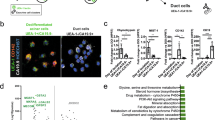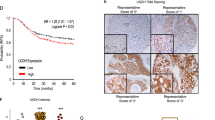Abstract
Expression of the antioxidant enzyme EcSOD in normal human mammary epithelial cells was not recognized until recently. Although expression of EcSOD was not detectable in non-malignant human mammary epithelial cells (HMEC) cultured in conventional two-dimensional (2D) culture conditions, EcSOD protein expression was observed in normal human breast tissues, suggesting that the 2D-cultured condition induces a repressive status of EcSOD gene expression in HMEC. With the use of laminin-enriched extracellular matrix (lrECM), we were able to detect expression of EcSOD when HMEC formed polarized acinar structures in a 3D-culture condition. Repression of the EcSOD-gene expression was again seen when the HMEC acini were sub-cultured as a monolayer, implying that lrECM-induced acinar morphogenesis is essential in EcSOD-gene activation. We have further shown the involvement of DNA methylation in regulating EcSOD expression in HMEC under these cell culture conditions. EcSOD mRNA expression was strongly induced in the 2D-cultured HMEC after treatment with a DNA methyltransferase inhibitor. In addition, epigenetic analyses showed a decrease in the degree of CpG methylation in the EcSOD promoter in the 3D versus 2D-cultured HMEC. More importantly, >80% of clinical mammary adenocarcinoma samples showed significantly decreased EcSOD mRNA and protein expression levels compared with normal mammary tissues and there is an inverse correlation between the expression levels of EcSOD and the clinical stages of breast cancer. Combined bisulfite restriction analysis analysis of some of the tumors also revealed an association of DNA methylation with the loss of EcSOD expression in vivo. Furthermore, overexpression of EcSOD inhibited breast cancer metastasis in both the experimental lung metastasis model and the syngeneic mouse model. This study suggests that epigenetic silencing of EcSOD may contribute to mammary tumorigenesis and that restoring the extracellular superoxide scavenging activity could be an effective strategy for breast cancer treatment.
This is a preview of subscription content, access via your institution
Access options
Subscribe to this journal
Receive 50 print issues and online access
$259.00 per year
only $5.18 per issue
Buy this article
- Purchase on Springer Link
- Instant access to full article PDF
Prices may be subject to local taxes which are calculated during checkout







Similar content being viewed by others
References
Oberley LW, Buettner GR . Role of superoxide dismutase in cancer: a review. Cancer Res 1979; 39: 1141–1149.
Oberley LW, Oberley TD, Buettner GR . Cell division in normal and transformed cells: the possible role of superoxide and hydrogen peroxide. Med Hypotheses 1981; 7: 21–42.
Gius D, Spitz DR . Redox signaling in cancer biology. Antioxid Redox Signal 2006; 8: 1249–1252.
Behrend L, Henderson G, Zwacka RM . Reactive oxygen species in oncogenic transformation. Biochem Soc Trans 2003; 31 (Pt 6): 1441–1444.
Oberley LW . Mechanism of the tumor suppressive effect of MnSOD overexpression. Biomed Pharmacother 2005; 59: 143–148.
Teoh-Fitzgerald ML, Fitzgerald MP, Jensen TJ, Futscher BW, Domann FE . Genetic and Epigenetic Inactivation of Extracellular Superoxide Dismutase Promotes an Invasive Phenotype in Human Lung Cancer by Disrupting ECM Homeostasis. Mol Cancer Res 2012; 10: 40–51.
Teodoridis JM, Strathdee G, Brown R . Epigenetic silencing mediated by CpG island methylation: potential as a therapeutic target and as a biomarker. Drug Resist Updat 2004; 7: 267–278.
Marklund SL . Extracellular superoxide dismutase in human tissues and human cell lines. J Clin Invest 1984; 74: 1398–1403.
Teoh ML, Fitzgerald MP, Oberley LW, Domann FE . Overexpression of extracellular superoxide dismutase attenuates heparanase expression and inhibits breast carcinoma cell growth and invasion. Cancer Res 2009; 69: 6355–6363.
Petersen OW, Ronnov-Jessen L, Howlett AR, Bissell MJ . Interaction with basement membrane serves to rapidly distinguish growth and differentiation pattern of normal and malignant human breast epithelial cells. Proc Natl Acad Sci USA 1992; 89: 9064–9068.
Weaver VM, Lelievre S, Lakins JN, Chrenek MA, Jones JC, Giancotti F et al. Beta4 integrin-dependent formation of polarized three-dimensional architecture confers resistance to apoptosis in normal and malignant mammary epithelium. Cancer Cell 2002; 2: 205–216.
Kenny PA, Lee GY, Myers CA, Neve RM, Semeiks JR, Spellman PT et al. The morphologies of breast cancer cell lines in three-dimensional assays correlate with their profiles of gene expression. Mol Oncol 2007; 1: 84–96.
Edovitsky E, Elkin M, Zcharia E, Peretz T, Vlodavsky I . Heparanase gene silencing, tumor invasiveness, angiogenesis, and metastasis. J Natl Cancer Inst. 2004; 96: 1219–1230.
Adachi T, Kodera T, Ohta H, Hayashi K, Hirano K . The heparin binding site of human extracellular-superoxide dismutase. Arch Biochem Biophys 1992; 297: 155–161.
Hicks CL, Bucy J, Stofer W . Heat inactivation of superoxide dismutase in bovine milk. J Dairy Sci 1979; 62: 529–532.
Hicks CL . Occurrence and consequence of superoxide dismutase in milk products: a review. J Dairy Sci 1980; 63: 1199–1204.
Jones PA . DNA methylation and cancer. Oncogene 2002; 21: 5358–5360.
Laukkanen MO, Mannermaa S, Hiltunen MO, Aittomaki S, Airenne K, Janne J et al. Local hypomethylation in atherosclerosis found in rabbit ec-sod gene. Arterioscler Thromb Vasc Biol 1999; 19: 2171–2178.
Garbe JC, Holst CR, Bassett E, Tlsty T, Stampfer MR . Inactivation of p53 function in cultured human mammary epithelial cells turns the telomere-length dependent senescence barrier from agonescence into crisis. Cell Cycle 2007; 6: 1927–1936.
Novak P, Jensen TJ, Garbe JC, Stampfer MR, Futscher BW . Stepwise DNA methylation changes are linked to escape from defined proliferation barriers and mammary epithelial cell immortalization. Cancer Res 2009; 69: 5251–5258.
Li Y, Pan J, Li JL, Lee JH, Tunkey C, Saraf K et al. Transcriptional changes associated with breast cancer occur as normal human mammary epithelial cells overcome senescence barriers and become immortalized. Mol Cancer 2007; 6: 7.
Chen LH, Bissell MJ . A novel regulatory mechanism for whey acidic protein gene expression. Cell Regul 1989; 1: 45–54.
Jolivet G, Pantano T, Houdebine LM . Regulation by the extracellular matrix (ECM) of prolactin-induced alpha s1-casein gene expression in rabbit primary mammary cells: role of STAT5, C/EBP, and chromatin structure. J Cell Biochem 2005; 95: 313–327.
Xu R, Spencer VA, Bissell MJ . Extracellular matrix-regulated gene expression requires cooperation of SWI/SNF and transcription factors. J Biol Chem 2007; 282: 14992–14999.
Tahiliani M, Koh KP, Shen Y, Pastor WA, Bandukwala H, Brudno Y et al. Conversion of 5-methylcytosine to 5-hydroxymethylcytosine in mammalian DNA by MLL partner TET1. Science 2009; 324: 930–935.
Valinluck V, Sowers LC . Endogenous cytosine damage products alter the site selectivity of human DNA maintenance methyltransferase DNMT1. Cancer Res 2007; 67: 946–950.
Wu H, D'Alessio AC, Ito S, Xia K, Wang Z, Cui K et al. Dual functions of Tet1 in transcriptional regulation in mouse embryonic stem cells. Nature 2011; 473: 389–393.
Hewetson A, Hendrix EC, Mansharamani M, Lee VH, Chilton BS . Identification of the RUSH consensus-binding site by cyclic amplification and selection of targets: demonstration that RUSH mediates the ability of prolactin to augment progesterone-dependent gene expression. Mol Endocrinol 2002; 16: 2101–2112.
Vukicevic S, Kleinman HK, Luyten FP, Roberts AB, Roche NS, Reddi AH . Identification of multiple active growth factors in basement membrane Matrigel suggests caution in interpretation of cellular activity related to extracellular matrix components. Exp Cell Res 1992; 202: 1–8.
Henrotin Y, Deberg M, Mathy-Hartert M, Deby-Dupont G . Biochemical biomarkers of oxidative collagen damage. Adv Clin Chem 2009; 49: 31–55.
Bernfield M, Gotte M, Park PW, Reizes O, Fitzgerald ML, Lincecum J et al. Functions of cell surface heparan sulfate proteoglycans. Annu Rev Biochem 1999; 68: 729–777.
Raats CJ, Bakker MA, van den Born J, Berden JH . Hydroxyl radicals depolymerize glomerular heparan sulfate in vitro and in experimental nephrotic syndrome. J Biol Chem 1997; 272: 26734–26741.
Lee GY, Kenny PA, Lee EH, Bissell MJ . Three-dimensional culture models of normal and malignant breast epithelial cells. Nat Methods 2007; 4: 359–365.
Tang X, Sun Z, Runne C, Madsen J, Domann F, Henry M et al. A critical role of Gbetagamma in tumorigenesis and metastasis of breast cancer. J Biol Chem 2011; 286: 13244–13254.
Blaschke RJ, Howlett AR, Desprez PY, Petersen OW, Bissell MJ . Cell differentiation by extracellular matrix components. Methods Enzymol 1994; 245: 535–556.
Case AJ, McGill JL, Tygrett LT, Shirasawa T, Spitz DR, Waldschmidt TJ et al. Elevated mitochondrial superoxide disrupts normal T cell development, impairing adaptive immune responses to an influenza challenge. Free Radic Biol Med 2011; 50: 448–458.
Teoh ML, Sun W, Smith BJ, Oberley LW, Cullen JJ . Modulation of reactive oxygen species in pancreatic cancer. Clin Cancer Res 2007; 13: 7441–7450.
Shan W, Zhong W, Zhao R, Oberley TD . Thioredoxin 1 as a subcellular biomarker of redox imbalance in human prostate cancer progression. Free Radic Biol Med 2010; 49: 2078–2087.
Rose SL, Fitzgerald MP, White NO, Hitchler MJ, Futscher BW, De Geest K et al. Epigenetic regulation of maspin expression in human ovarian carcinoma cells. Gynecol Oncol 2006; 102: 319–324.
Svensson RU, Barnes JM, Rokhlin OW, Cohen MB, Henry MD . Chemotherapeutic agents up-regulate the cytomegalovirus promoter: implications for bioluminescence imaging of tumor response to therapy. Cancer Res 2007; 67: 10445–10454.
Drake JM, Gabriel CL, Henry MD . Assessing tumor growth and distribution in a model of prostate cancer metastasis using bioluminescence imaging. Clin Exp Metastasis 2005; 22: 674–684.
Acknowledgements
The authors thank Dr James Crapo (National Jewish Medical and Research Center, Denver, CO, USA) for providing antibodies to EcSOD and Dr Michael Henry (Department of Molecular Physiology and Biophysics, University of Iowa, IA, USA) for providing the 4T1.luc cells. We also thank Justin Fishbaugh from the Flow Cytometry Core Facility for assisting with the DCFH assays as well as the Central Microscopy Research Facility. This study was supported by NIH grant R01 CA073612 and R01 CA115438 (FE Domann), Susan G Komen for the Cure grant KG080437 (M Teoh-Fitzgerald), SFRBM Research Mini-Fellowship (M Teoh-Fitzgerald), Oberley Seed Grant (M Teoh-Fitzgerald), and Carver Research Program of Excellence in Redox Biology and Medicine, and by the Holden Comprehensive Cancer Center Breast Cancer Research Fund.
Author information
Authors and Affiliations
Corresponding authors
Ethics declarations
Competing interests
The authors declare no conflict of interest.
Additional information
Supplementary Information accompanies the paper on the Oncogene website
Supplementary information
Rights and permissions
About this article
Cite this article
Teoh-Fitzgerald, M., Fitzgerald, M., Zhong, W. et al. Epigenetic reprogramming governs EcSOD expression during human mammary epithelial cell differentiation, tumorigenesis and metastasis. Oncogene 33, 358–368 (2014). https://doi.org/10.1038/onc.2012.582
Received:
Revised:
Accepted:
Published:
Issue Date:
DOI: https://doi.org/10.1038/onc.2012.582
Keywords
This article is cited by
-
Upregulation of Nox4 induces a pro-survival Nrf2 response in cancer-associated fibroblasts that promotes tumorigenesis and metastasis, in part via Birc5 induction
Breast Cancer Research (2022)
-
Urinary protein biomarker panel predicts esophageal squamous carcinoma from control cases and other tumors
Esophagus (2022)
-
SOD3 improves the tumor response to chemotherapy by stabilizing endothelial HIF-2α
Nature Communications (2018)
-
Overexpression of glutathione peroxidase 1 predicts poor prognosis in oral squamous cell carcinoma
Journal of Cancer Research and Clinical Oncology (2017)
-
Oxidative stress inhibits distant metastasis by human melanoma cells
Nature (2015)



